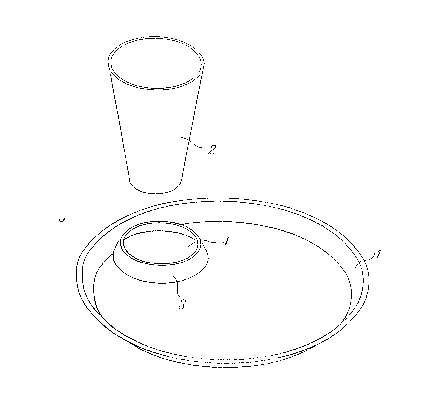Une partie des informations de ce site Web a été fournie par des sources externes. Le gouvernement du Canada n'assume aucune responsabilité concernant la précision, l'actualité ou la fiabilité des informations fournies par les sources externes. Les utilisateurs qui désirent employer cette information devraient consulter directement la source des informations. Le contenu fourni par les sources externes n'est pas assujetti aux exigences sur les langues officielles, la protection des renseignements personnels et l'accessibilité.
L'apparition de différences dans le texte et l'image des Revendications et de l'Abrégé dépend du moment auquel le document est publié. Les textes des Revendications et de l'Abrégé sont affichés :
| (12) Demande de brevet: | (11) CA 2067604 |
|---|---|
| (54) Titre français: | ASSIETTE PORTE-VERRE |
| (54) Titre anglais: | PLATE WITH MEANS FOR RECEIVING AND HOLDING A CUP |
| Statut: | Réputée abandonnée et au-delà du délai pour le rétablissement - en attente de la réponse à l’avis de communication rejetée |
| (51) Classification internationale des brevets (CIB): |
|
|---|---|
| (72) Inventeurs : |
|
| (73) Titulaires : |
|
| (71) Demandeurs : | |
| (74) Agent: | |
| (74) Co-agent: | |
| (45) Délivré: | |
| (22) Date de dépôt: | 1992-03-25 |
| (41) Mise à la disponibilité du public: | 1993-03-04 |
| Licence disponible: | S.O. |
| Cédé au domaine public: | S.O. |
| (25) Langue des documents déposés: | Anglais |
| Traité de coopération en matière de brevets (PCT): | Non |
|---|
| (30) Données de priorité de la demande: | ||||||
|---|---|---|---|---|---|---|
|
ABSTRACT
A novel plate or dish for receiving and holding a cup
is disclosed and is particularly suitable at picnics, with take-
out meal services and when eating on moving vehicles such as
planes or trains. Further, the plates or dishes of this
invention and which include means for receiving and holding a cup
can be made, if desired, of any disposable material and can be
conveniently stacked one on top of the other for storage
purposes. The means for receiving and holding a cup located on
the plate or dish is in the form of an opening, or a recessed
surface of a raised surface on the plate or dish, or a
combination thereof. As an opening, it is preferably circular
so as to receivingly engage a conical cup; the circular opening
preferably being provided on a raised surface of the plate. The
plate may also be divided into several sections by means of
partition bars so that different food items, in addition to the
cup, can be placed in different compartments on the plate.
Note : Les revendications sont présentées dans la langue officielle dans laquelle elles ont été soumises.
Note : Les descriptions sont présentées dans la langue officielle dans laquelle elles ont été soumises.

2024-08-01 : Dans le cadre de la transition vers les Brevets de nouvelle génération (BNG), la base de données sur les brevets canadiens (BDBC) contient désormais un Historique d'événement plus détaillé, qui reproduit le Journal des événements de notre nouvelle solution interne.
Veuillez noter que les événements débutant par « Inactive : » se réfèrent à des événements qui ne sont plus utilisés dans notre nouvelle solution interne.
Pour une meilleure compréhension de l'état de la demande ou brevet qui figure sur cette page, la rubrique Mise en garde , et les descriptions de Brevet , Historique d'événement , Taxes périodiques et Historique des paiements devraient être consultées.
| Description | Date |
|---|---|
| Inactive : CIB de MCD | 2006-03-11 |
| Le délai pour l'annulation est expiré | 2000-03-27 |
| Demande non rétablie avant l'échéance | 2000-03-27 |
| Réputée abandonnée - omission de répondre à un avis sur les taxes pour le maintien en état | 1999-03-25 |
| Inactive : Abandon.-RE+surtaxe impayées-Corr envoyée | 1999-03-25 |
| Demande publiée (accessible au public) | 1993-03-04 |
| Date d'abandonnement | Raison | Date de rétablissement |
|---|---|---|
| 1999-03-25 |
Le dernier paiement a été reçu le 1998-02-16
Avis : Si le paiement en totalité n'a pas été reçu au plus tard à la date indiquée, une taxe supplémentaire peut être imposée, soit une des taxes suivantes :
Les taxes sur les brevets sont ajustées au 1er janvier de chaque année. Les montants ci-dessus sont les montants actuels s'ils sont reçus au plus tard le 31 décembre de l'année en cours.
Veuillez vous référer à la page web des
taxes sur les brevets
de l'OPIC pour voir tous les montants actuels des taxes.
| Type de taxes | Anniversaire | Échéance | Date payée |
|---|---|---|---|
| TM (demande, 6e anniv.) - petite | 06 | 1998-03-25 | 1998-02-16 |
Les titulaires actuels et antérieures au dossier sont affichés en ordre alphabétique.
| Titulaires actuels au dossier |
|---|
| CHI MAN LAM |
| Titulaires antérieures au dossier |
|---|
| S.O. |